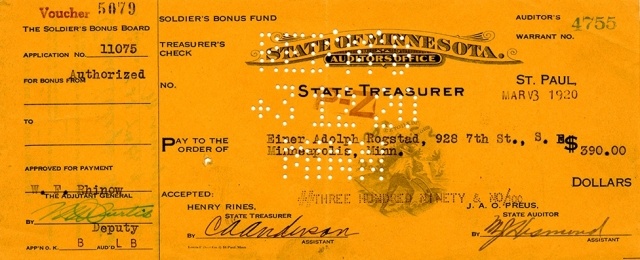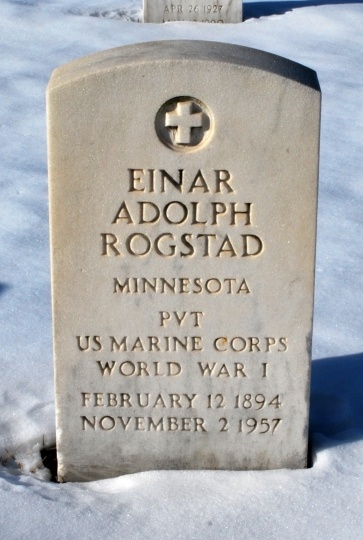Einar A. Rogstad, from Becker County, Minnesota, joined the United States Marine Corps (USMC) in 1917 to fight in World War I. He served overseas from May 1918 to May 1919, fighting at St. Mihiel, Marbache, Champaigne, and in the Meus-Argonne Offensive. After the signing of the Treaty of Versailles, he remained in Europe during peacetime as part of the Army of Occupation.
Einar A. Rogstad was born on February 12, 1894, to Norwegian immigrants Thomas and Karen Rogstad in Detroit Lakes, Minnesota. He entered the Marine Corps as a private on May 10, 1917. Assigned to the 77th Company of the 6th Machine Gun Battalion, USMC Second Division, he trained in Mare Island, California, onboard the USS Buffalo, and at Norfolk, Virginia. He traveled to Fort Crockett in Galveston, Texas, for further instruction in November 1917, completing his training at the US Marine Corps base at Quantico, Virginia, the following May.
Assigned as a Private with the 77th Company of the 6th Machine Gun Battalion, USMC 2nd Division, Rogstad left for service overseas on the USS Frederick on May 27, 1918. He served in campaigns at St. Mihiel, Marbache, Champagne, and Meuse-Argonne.
In a letter written on October 3, 1918, to his brother, Ferdinand, Einar described his experiences on the front to living inside an inferno. He also shared his happiness in receiving a box of cookies and a bar of chocolate that night before discussing the horrors of the front lines:
“At daybreak…we went over in the first wave to make a surprise attack. The Boche beat us to it. They came yelling like mad men. At once we got busy though appearances were not favorable. With pistols they were held off until we got our machine guns in action. Hand grenades were falling terribly close but when we begin to sweep the woods with a steady stream of machine gun bullets they retreated. Their aeroplanes swooped down on us with machine gun fire but didn’t do much damage. You ought to hear them holler ‘Kammerad’ when the ‘jig is up.’…The experience is very uncomfortable and yet one can go through shell and machine gun fire without getting scratched.”
Rogstad wrote of the horrors of war and the desolation of no man's land. He shared his belief that his wartime experiences made him a wiser and better man.
Rogstad continued to fight until the signing of the Armistice on November 11, 1918. He remained in Europe with the Army of Occupation until he returned home in June 1918.
Rogstad mustered out on June 25, 1919 at Quantico, Virginia. He lived for nearly four more decades and died on November 2, 1957. Because of his status as a veteran, he was buried in Fort Snelling National Cemetery.







